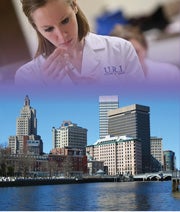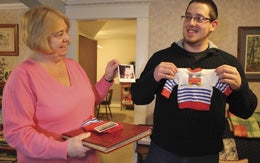Nursing Profs Deliver Big Baby News

Picture a neonatal intensive care unit. Premature babies, some as tiny as the palm of an adult hand, lie in incubators linked to monitors and life-saving equipment. The care is extraordinary, the devotion unceasing, but so is the worry about the next minute, the next month, the next ten years, especially for parents.
What if research showed that for these little ones, a simple delivery room procedure, or an intervention in elementary school, could mean improved health and easier transitions to adult life?
That kind of research has been under way for years, thanks to two University of Rhode Island nursing professors. Interim Dean of the College of Nursing Mary Sullivan, Ph.D. ’94, is spearheading the longest-running study in the U.S. of premature infants, to see what types of interventions mitigate the effects of early birth. Her colleague, Clinical Professor Emerita Judith Mercer, has already found that delaying the clamping of umbilical cords for pre-term babies produces dramatic health benefits. Now, together with Assistant Nursing Professor Debra Erickson-Owens, Ph.D.’09, she is in the midst of another study of whether that simple delay benefits full-term babies.

Future of nursing in Rhode Island
The work of Mary Sullivan and Judith Mercer underscores the wisdom of a shared URI/RIC Life Sciences/Nursing Education Center in the Providence Knowledge District.
Both URI nursing professors also hold appointments as research scientists at Women & Infants Hospital and as adjunct professors of pediatrics at Brown University’s Alpert Medical School. During the heaviest demands on their research projects, they spend as much time in Providence as in Kingston—perhaps more. And they are not alone. URI nursing professors hold clinical and research appointments at Hasbro Children’s Hospital, The Miriam Hospital, Rhode Island Hospital, Butler Hospital, the Rhode Island Free Clinic, Crossroads Rhode Island, Bradley Hospital in nearby East Providence, and the state Department of Corrections in Cranston, among others.
Meanwhile, faced with a potential statewide shortage of 6,500 nurses by the year 2020, a study of nursing education commissioned by the Rhode Island General Assembly recommends that a shared educational and research facility for URI and Rhode Island College be built in Providence. Such a facility would be equipped with the latest technology and would allow URI and RIC to increase combined undergraduate enrollment from 1,161 to 1,745, and graduate enrollment from 131 to 399.
Governor Lincoln Chafee regularly speaks about the importance of investing in the state’s “Meds and Eds.” His current budget includes $500,000 for architectural and engineering work to move forward with the project.
“Since the health care and education industries are two of Rhode Island’s strongest, support for such a project will have immediate results,” said President David. M. Dooley. “It will allow us to bolster enrollment in the state’s public nursing programs that prepare the greatest number of nurses with bachelor’s and advanced practice degrees in Rhode Island.”
In the Delivery Room
As Mercer compiles her results from a $2 million, five-year study funded by the National Institutes of Health (NIH) on the impacts of delayed cord clamping for pre-term infants, she and Erickson-Owens have teamed with Women & Infants Hospital, and Brown University’s Sean Deoni, director of the Advanced Baby Imaging Lab, to study delayed clamping in full-term babies. NIH has awarded the team a five-year, $2.4 million grant to study 128 infants from birth to 24 months to measure the effect of delaying cord clamping on the structure and functioning of the developing brain. Called the Infant Brain Study, it also received a $100,000 grant from the Bill & Melinda Gates Foundation.
Mothers are enrolled prenatally, and their babies are assigned to a study group when they are born at Women & Infants. At four, ten, and 24 months, they go to the Brown baby imaging lab for magnetic resonance imaging (MRI) scans and developmental testing.
“Mom comes in with the baby, and goes to the quiet room, which is set up like a baby’s room, until the baby falls asleep,” Mercer explained. “Once the baby settles, he or she is put on a cart that slides right into the scanner. They put earmuffs on the baby…. One time, a baby woke up, but mom was able to get her child back to sleep and the study was completed. An MRI, unlike an X-ray, puts out less energy than one’s cell phone and is considered a safe procedure.
“Sean has this set up in a very special way,” Mercer added. “It’s not noisy, and he doesn’t use any sedation. It’s a little smaller than a regular MRI. They have done over 250 scans of infants and children, so he has it down to a science.”
Mercer and her team want to find out if delaying the clamping of the umbilical cord, which allows the placenta to transfer iron-rich blood to the newborn, reduces iron deficiency and anemia in the first year for full-term newborns. The MRI scan results can also determine whether delayed clamping enhances myelination in the brain. Iron is required for the process of forming myelin sheaths around nerves in the brain. Good myelin sheaths allow impulses to move more quickly and are critical to a healthy nervous system.
No Longer Babies
For more than two decades, Mary Sullivan has overseen this country’s longest-running study of premature infants. Brown University launched the study a quarter century ago, but Margaret McGrath, URI nursing professor emerita, took it over in 1989, and Sullivan joined the research team in 1990. More than $7 million in federal funding later, Sullivan and her project manager of 17 years, Suzy Winchester, have watched their fragile subjects grow into healthy adults.
Sullivan’s findings, which have been shared around the country and in Europe, show how supportive, loving parents, nurturing school environments, and stimulating factors work to offset the delays pre-term infants experience in their physical, academic, and social development.
Study subject Sean Foster, a 25-year-old employee at BJ’s in Coventry and a student at New England Technical Institute, is a great example of the effects of a nurturing parent. His mother, Catherine Foster ’74, M.A. ’87, recalls how she could hold him in one hand when he was born at 26 weeks weighing 1.5 pounds. Now, he stands 6 feet, 1 inch, and weighs 240 pounds.
Why did she agree to enlist her son in the study when she faced so many demands?
“The team gave me great reasons to be involved, and I knew that my son would get regular monitoring as he grew,” said the physical education teacher at Deering Middle School in West Warwick. “I had to keep daily logs for a while, and I remember he took his first steps at Women & Infants.”
“My first memory of being in the study was when I was asked to bring my best friend Jerry to the hospital,” Sean said. “They videotaped me on how I worked with other people as we played Nintendo 64.”
While the Fosters often went to the hospital for assessments, Sullivan, Winchester, and the other team members also visited Sean’s schools and home.
Sean exhibited delays in his gross motor skills, but that didn’t stop Cathy from doing everything she could to give him an active childhood.
“I faced two issues: single-parenthood when Sean was three months old, and I had to work,” she said. “It was tough, but we did stuff, especially all the free activities we could find. I made him write in a journal, and we redeemed aluminum cans for gas money so we could go on short trips. We played memory games all the time.”
Both she and Sean express overwhelmingly positive feelings about their participation in the study. “It’s been a good experience,” said Sean, who is now engaged to be married.
“I am a 1974 health and physical education major from URI, and I am proud to know that my University is doing this kind of work,” Cathy said. “I am also glad that our participation may help other babies and parents.”

“Rhode Island Born, Rhode Island Bred”
The words of the Rhody fight song resonate strongly with Jenna Richardson ’09, a nurse at Our Lady of Fatima Hospital who now interacts with Sullivan’s research team as a fellow professional. In 1986, she and her twin sister, Kelley, were born at 32 weeks, with Jenna weighing 1 pound, 2.3 ounces and Kelley weighing 1 pound, 2.5 ounces. They have a 23-year-old sister, Melanie, who was born full term.
Their parents, Amy and Phil, needed plenty of help in those early years.
“The people at Women & Infants were superb,” Amy said. “What they did for the babies was amazing. You could call anytime.” And the members of the study team, she said, “were just so nice from the beginning, you wanted to do it for them.”
That support was important for parents who had to connect Jenna to a sleep apnea machine for the first year of her life, and who dealt with children who were sick frequently. At age two, both twins were plagued with asthma.
Amy said her children benefited from a great pre-school where they got individual attention that detected any delays, outstanding education in parochial elementary and secondary schools, and the benefit of constant interaction as only twins can experience.
As a URI nursing student, Jenna met Sullivan and completed one of her clinical rotations at Women & Infants. “One of the nurses mentioned the study, and I told the group that I was a participant,” Jenna said. “It has been great being a part of the study, especially since I am a nurse. Maybe our participation will make it a little easier for the babies of the future.”
Her twin, Kelley, has a bachelor’s degree in economics from the College of the Holy Cross and works for Deloitte Consulting, Hartford, Conn. as a human capital financial services consultant.
The project changed Kelley’s perceptions of nursing. “I thought it was mostly hospital-based. I have so much respect for nurses, not that I didn’t before, but this really opened my eyes to what they are doing.”
So What’s Next?
Sullivan and Winchester, whose last $2.4 million grant is ending this year, want to apply for another NIH grant to study the young adults further.
“We want to focus on health and daily functioning,” Sullivan said. “We want to look at the really big picture, how they manage their affairs every day, hold a job, have social interactions, maintain a household.”
Will the study subjects continue if Sullivan is awarded another grant?
Sarah Medeiros, 25, of Portsmouth, like her fellow participants, says, “Of course.” She was born ten weeks early, weighing 2 pounds, 2 ounces. Now an analyst at Newport Federal Savings Bank, she is completing her bachelor’s degree in business management at Roger Williams University.
Extremely grateful for and inspired by the many sacrifices of her parents, Barbara and Jeff, she is also deeply impressed with Sullivan’s work.
“She has done so many amazing things, and we have come so far in the research because of her,” Medeiros said.
—Dave Lavallee ’79, M.P.A. ’87
 Home
Home Browse
Browse Close
Close Events
Events Maps
Maps Email
Email Brightspace
Brightspace eCampus
eCampus


